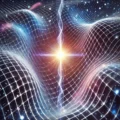Journey through the Galactic Impedance Gradient
Abstract
This paper explores the concept of an impedance gradient within a solitary galaxy in an otherwise empty universe. Through a thought experiment, it examines how spacetime impedance varies from the galactic center to its edges, influencing gravitational forces, time, and cosmic structure.
Introduction
Imagine a universe containing only one galaxy, surrounded by the vastness of empty space. This thought experiment delves into the implications of the impedance gradient within this solitary galaxy.
Core Concept
You find yourself at the center of the galaxy, the black hole, where gravitational forces are strongest. Here, spacetime appears smooth and undisturbed, allowing for stable orbits and a sense of cosmic tranquility. As you venture outward from the galactic core towards the galaxy’s edges, you encounter variations in spacetime impedance. The once-serene environment gives way to a complex interplay of gravitational fields, stars, gas clouds, and dark matter.
Near-Zero Impedance at the Galactic Center: At the heart of the galaxy, you experience a sense of calmness, where spacetime impedance is minimal. Stars and celestial bodies orbit the galactic nucleus in graceful arcs at their highest speeds.
Increasing Impedance Towards the Galactic Edges: Moving outward, you observe a gradual increase in spacetime impedance. Gravitational effects become less pronounced, shaping the galactic landscape and influencing the flow of cosmic matter.
Lorentzian Time and Impedance: As you traverse through regions of varying impedance, you notice fluctuations in the speed of energy, which manifest as changes in the passage of time. In areas of varying impedance, time dilation or contraction occurs, reflecting the intricate interplay between gravity and spacetime curvature.
Observational Insights: Along your journey, you encounter intriguing phenomena such as gravitational lensing, where energy density distorts the light from distant objects, offering glimpses into the underlying gravitational contours of the galaxy.
Impedance Poles and Energy Reflection:
It becomes apparent that the two extremes of this impedance gradient—the black hole and open space—act as poles, defining the boundaries of the tapered impedance of space. Both poles result in reflected energy, with one inverting the reflection and the other amplifying it.
Discussion
Spacetime Impedance: The concept of “spacetime impedance” is central to this thought experiment. While not a standard term in cosmology, it provides a useful analogy for understanding how different regions of space resist or facilitate the propagation of energy and matter. In this context, impedance is related to the strength of gravitational fields and the curvature of spacetime.
Galactic Structure: The experiment illustrates how the impedance gradient shapes the structure of the galaxy. At the center, low impedance allows for high speeds and stable orbits, while towards the edges, increasing impedance influences the distribution of matter and the dynamics of celestial objects.
Time Dilation: The connection between impedance and time dilation is a key aspect of the experiment. It suggests that variations in spacetime impedance can lead to changes in the flow of time, consistent with the principles of general relativity
Energy Reflection: The idea that the black hole and open space act as impedance poles, reflecting energy in different ways, is a thought-provoking concept. It raises questions about the nature of energy at the boundaries of the universe and the potential for energy to be recycled or transformed.
Conclusion
This mind experiment provides a theoretical framework for exploring the concept of a galactic impedance gradient. It suggests that variations in spacetime impedance play a crucial role in shaping the structure and dynamics of galaxies, influencing gravity, time, and the behavior of energy. Further investigation into these concepts could lead to a deeper understanding of the fundamental properties of the cosmos.
